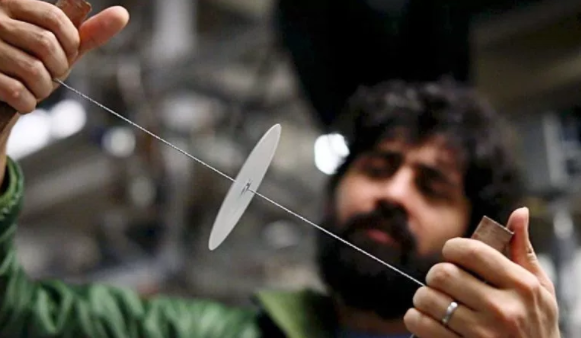
SAN FRANCISCO (Diya TV) – An Indian-American professor at Stanford University has developed a whirligig centrifuge that has the potential to reinvent the separation of blood plasma from red blood cells. Researchers and scientists have been using centrifuge tubes since their invention in 1938, however, now it looks like things are changing.
Here’s how to build a whirligig: Thread a loop of twine through two holes in a button. Grab the loop ends, then rhythmically pull. As the twine coils and uncoils, the button spins at a dizzying speed.
Using this ancient technology, Manu Prakash and Stanford bioengineers have created an ultra-low-cost, human-powered centrifuge that separates blood into its individual components in only 1.5 minutes. Built from 20 cents of paper, twine and plastic, a “paperfuge” can spin at speeds of 125,000 rpm and exert centrifugal forces of 30,000 Gs.
“To the best of my knowledge, it’s the fastest spinning object driven by human power,” Prakash, an assistant professor of bioengineering at Stanford, told the university’s website.
A laboratory centrifuge is critical for detecting diseases such as malaria, African sleeping sickness, HIV and tuberculosis. This low-cost version will enable precise diagnosis and treatment in the poor, off-the-grid regions where these diseases are most prevalent. The physics and test results of the device were published in the Jan. 10 issue of Nature Biomedical Engineering.
When used for disease testing, a centrifuge separates blood components and makes pathogens easier to detect. A typical centrifuge, powered by electricity, spins fluid samples inside a rotating drum. As the drum spins, centrifugal forces separate fluids by density into layers within a sample tube.
Prakash, who specializes in low-cost diagnostic tools for underserved regions, came up with the idea for the centrifuge after he saw an expensive version of the device being used as a doorstop in a rural clinic in Uganda because there was no electricity to run it. His device requires no electricity.
“There are more than a billion people around the world who have no infrastructure, no roads, no electricity. I realized that if we wanted to solve a critical problem like malaria diagnosis, we needed to design a human-powered centrifuge that costs less than a cup of coffee,” he said.
Information from Stanford News Service contributed to this report.




